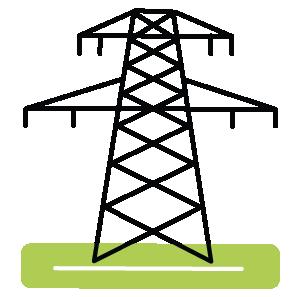
3 minute read
1 .5 . Accelerating and securing the delivery of critical infrastructure

Transgrid is working to ensure our supply chain remains strong and accelerate where possible. Our Powering Tomorrow Together program will accelerate and secure critical infrastructure projects, using a bundling approach to de-risk supply chain and financial pressures.
The Powering Tomorrow Together program, the bundling of procurement for the EnergyConnect, HumeLink and VNI West projects will allow Transgrid to negotiate long-term supply agreements for new equipment and materials necessary, with advance orders that put us ahead of global competition. Transgrid has already secured key equipment with Hitachi Energy, including signing a contract to supply 15 500kV shunt reactors for use on the VNI West and HumeLink projects. The Powering Tomorrow Together program will support further purchasing at scale, ensuring the supply of:
• 14,500 km of transmission line conductor – enough to stretch from Sydney to Los Angeles
• 58,000 tonnes of steel to build 1,350 transmission towers Bundling projects into the Powering Tomorrow Together program will yield a capex saving of approximately $500 million, from savings in procurement, labour and avoided inflation costs that can be passed onto consumers. Combined with the savings from a threeyear acceleration of VNI West made possible by this program, NSW residential customer bills are projected to be reduced by $12 a year.
Powering Tomorrow Together
26. McKinsey, 2022, Building resilient supply chains for the European energy transition

27. McKinsey, 2022, Building resilient supply chains for the European energy transition https://www.mckinsey.com/industries/electric-power-and-natural-gas/our-insights/building-resilient-supply-chains-for-the-european-energy-transition
28. The Economist, 2023, Technology Quarterly 2023, https://www.economist.com/technology-quarterly/2023/04/05/adding-capacity-to-the-electricity-grid-is-not-a-simple-task
1 .6 . More than just poles and wires
To improve energy reliability, reduce delivery times and lower costs for consumers, Transgrid is developing multiple innovation projects using alternatives to traditional infrastructure. These projects are about unlocking capacity in our existing transmission network:
• Installing SmartValve technology at the Stockdill and Yass substations has enabled 170MW of extra energy to flow between Victoria and New South Wales – enough extra energy to power 30,000 NSW and ACT homes. SmartValves help to increase energy flows on existing transmission lines by diverting electricity from lines that are experiencing constraints to those better able to carry the electrical loads.
• Combining procured battery energy storage as a service at Parkes and Panorama with dynamic reactive power support devices will defer the construction of a new transmission line between Wellington and Parkes.
• Procuring battery energy storage as a service from a battery energy storage system in South-West NSW to increase transfer capacity on the existing network and defer the construction of a new transmission line between Darlington Point and Dinawan
• Procuring battery energy storage as a service at Gunnedah or Narrabri will cater for increased electricity demand from new industrial loads in the North West Slopes area of NSW, limiting new investment in traditional transmission infrastructure.
• Procuring compressed air storage as a service for backup supply at Broken Hill, when the single 220kV transmission line is out of service due to a planned or unplanned outage. Backup power supply was historically provided by two diesel-fired turbines owned and operated by Essential Energy.
• Facilitating the delivery of the 850MW Waratah Super Battery and delivering a special protection scheme and additional network upgrades to unlock capacity and energy security following the planned closure of the Eraring Power Station in mid-2025. The Waratah Super Battery provides a virtual transmission solution that unlocks latent capacity in the existing transmission system, allowing consumers in the Sydney, Newcastle, Wollongong demand centres to access more energy from existing generators.
These projects are just the beginning. As the clean energy transition powers forward, Transgrid must continue to test, trial, prove and implement innovative technologies that can unlock extra transmission capacity on our network and lower costs for NSW consumers.
1 .7 . Securing talent, growing skills
To ensure the delivery of Transgrid’s critical transmission projects, we will need to add over 400 permanent employees and many more contracted workers over the next 5 years. Much of this work will be in regional New South Wales, bringing new opportunities to these communities.
In the context of a major clean energy skills shortage, Transgrid is looking to develop future talent through up-skilling or side-skilling parts of the existing industrial workforce and nurturing emerging talent entering the workforce for the first time.
• Retaining, redeploying and reskilling the talent we know . We are creating more flexibility in how people can move around the organisation, so teams and skills can be redeployed as demand for roles shifts. Training will play a crucial role in this, enabling employees to handle ever more complex issues and contribute across functions. To ensure we have the construction talent on the ground to deliver transmission projects, we are implementing a re-engagement program to help contractors transition between projects.
• Attracting new talent from other markets . Transgrid has established a roadmap to recruit talent from other industries and from overseas. Within Australia, this includes pursuing alternative pathways for talent in the energy sector via cross-boarding development in aligned skills industries, including emergency services, defence, mining, manufacturing and oil and gas.
• Developing future talent in Australia . Transgrid is increasing the training available in regional centres that will host most of the state’s clean energy infrastructure. We are partnering with the regional universities in Wagga Wagga and Newcastle to develop opportunities and collaborative support for research, infrastructure, training, and education and employment pipelines for regional areas.







